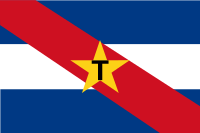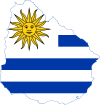Tupamaros
| Tupamaros - National Liberation Movement Movimiento de Liberación Nacional -Tupamaros | |
|---|---|
|
Tupamaros - National Liberation Movement Flag | |
| Leader(s) |
Raúl Sendic Eleuterio Fernández Huidobro Héctor Amodio Pérez Henry Engler Mauricio Rosencof |
| Dates of operation | 1967–1972 |
| Active region(s) | Uruguay |
| Ideology | Communism |
| Status | Inactive |
Part of a series on the |
|---|
| History of Uruguay |
 |
|
Independent State |
|
20th Century |
|
Modern Uruguay
|
|
|
Tupamaros, also known as the MLN-T (Movimiento de Liberación Nacional-Tupamaros or Tupamaros National Liberation Movement), was a left-wing urban guerrilla group in Uruguay in the 1960s and 1970s. The MLN-T is inextricably linked to its most important leader, Raúl Sendic, and his brand of social politics. José Mujica, who later became president of Uruguay, was also a member.
Activity
The Tupamaro movement was named after the revolutionary Túpac Amaru II, who in 1780 led a major indigenous revolt against the Viceroyalty of Peru. Its origins lie in the union between the Movimiento de Apoyo al Campesino (Peasant Support Movement), members of trade unions founded by Sendic in poverty-stricken rural zones, and radicalized cells of the Socialist Party of Uruguay.[1]
The movement began by staging the robbing of banks, gun clubs and other businesses in the early 1960s, then distributing stolen food and money among the poor in Montevideo. It took as its slogan, "Words divide us; action unites us."
At the beginning, it abstained from armed actions and violence, acting not as a guerrilla group but a political movement.[2] In June 1968, President Jorge Pacheco, trying to suppress labour unrest, enforced a state of emergency and repealed all constitutional safeguards. The government imprisoned political dissidents, used torture during interrogations, and brutally repressed demonstrations.[2] The Tupamaro movement engaged then in political kidnappings, "armed propaganda" and assassinations. Of particular note are the kidnapping of powerful bank manager Ulysses Pereira Reverbel and of the British ambassador to Uruguay, Geoffrey Jackson, as well as the assassination of Dan Mitrione, an American Federal Bureau of Investigation agent who the Tupamaros learned was advising the Uruguayan police in torture and other security work.[3][4]
The Tupamaros peaked as an insurgent force in 1970 and 1971. During this period they made liberal use of their Cárcel del Pueblo (or People's Prison) where they held those that they kidnapped and interrogated them, before making the results of these interviews public. A number of these hostages was later ransomed for considerable sums of money, including the Brazilian Consul in Montevideo, Aloysio Dias Gomide. In September 1971 over 100 imprisoned Tupamaros escaped the Punta Carretas prison by digging a hole across their cells and then a tunnel that led from the floor of one ground-level cell to the living room of a nearby home. As a result of this, the government summoned the military to prepare a counter-insurgency campaign to suppress the MLN.
Nonetheless, in 1972 the group was quickly crippled by a series of events. First, it had started to engage in political violence since 1970, a choice that weakened its popular support. Second, the group responded to the assassination and/or disappearance of four Tupamaros on the part of illegal parapolice squads with a wave of high-profile assassinations that concentrated political opposition against them. Later on, the MLN directly attacked the military and killed a number of soldiers. The army's response was swift; it included the heavy use of torture and the flipping of high-ranking Tupamaros, including Héctor Amodio Pérez, towards collaborating with them.[5]
The Tupamaros collapsed in mid-1972, with the army killing many of them and capturing a majority of the rest. Shortly after defeating the MLN the military successively confronted the independence of the judiciary in October 1972, of the civilian executive branch in February 1973, and lastly the independence of the parliament in June 1973. On this latter occasion it completed its coup d'état by deploying armored vehicles in the capital and shutting down the legislative branch. Nine Tupamaros were especially chosen to remain in squalid conditions, including Sendic, Fernández Huidobro, José Mujica, Henry Engler, and Mauricio Rosencof. They remained there until the restoration of liberal democracy in Uruguay in 1985. During the intervening years the military regime killed and "disappeared" additional numbers of people, focusing particularly on the Communist Party of Uruguay.[6]
List of attacks
- 31 July 1970 - kidnapping of CIA torture instructor Dan Mitrione, who was executed on 10 August.
- 31 July 1970 - kidnapping of the Brazilian consul Aloysio Dias Gomide, released on 21 February 1971 for ransom ($250,000).
- 7 August 1970 - kidnapping of US agronomist Dr. Claude Fly, released on 21 March 1971 after a health crisis following a heart attack inside the People's Prison.
- 29 September 1970 - bombing of the Carrasco Bowling Club, gravely injuring the elderly caretaker Hilaria Ibarra[7] (rescued from the rubble by Gustavo Zerbino who would later be a survivor of the Andes disaster).
- 8 January 1971 - kidnapping of the British ambassador Geoffrey Jackson.
- 21 December 1971 - killing of rural laborer Pascasio Báez by sodium pentothal injection
- 18 April 1972 - four Uruguayan Army soldiers killed by machine gun fire while watching over the house of the commander-in-chief of the Army, General Florencio Gravina.[8]
Notable members
- The Uruguayan "nine hostages" kept under duress between 1972-85:
- Raúl Sendic - Founder and leader of the group. Famous for his self-effacing, timid nature.
- Eleuterio Fernández Huidobro - Became a prominent politician beginning in the mid-1990s.
- José Mujica - Inaugurated as president of Uruguay in March 2010.
- Mauricio Rosencof - Became a prominent writer and playwright after leaving prison.
- Henry Engler - Left for Sweden post-prison and became a prominent medical researcher.
- Adolfo Wasem - Died of cancer before liberation.
- Jorge Zabalza - The youngest of the "nine hostages". Famous in Uruguay for his continued radical militancy well into the present day.
- Julio Marenales
- Jorge Manera
- Héctor Amodio Pérez - The only prominent and founding member of the Tupamaros to have defected to the government side. He escaped to Spain in 1973 and only resurfaced in the public eye in 2013.[9]
See also
- Movimiento de Participación Popular
- Kristina Konrad, Greater Freedom, Lesser Freedom 2000. Documentary film.
References
- ↑ "Pablo Brum's "The Robin Hood Guerrillas: The Epic Journey of Uruguay's Tupamaros (CreateSpace, 2014). Pages 38-44.".
- 1 2 Benjamín Nahum's El Fin Del Uruguay Liberal (Ediciones de la Banda Oriental, 1991) Volume 8 in Historia Uruguaya series
- ↑ http://www.nytimes.com/1987/06/21/world/uruguayan-clears-up-state-of-siege-killing.html
- ↑ Manuel Hevia Cosculluela, Pasaporte 11333: Ocho Años con la CIA, Havana, 1978, p. 286; see also "Dan Mitrione, un maestro de la tortura", Clarín, September 2, 2001 (Spanish)
- ↑ Brum, "The Robin Hood Guerrillas", Pages 245-280
- ↑ Brum, The Robin Hood Guerrillas, Pages 305-336.
- ↑ "Las dos muertes de Hilaria".
- ↑ Heinz, Wolfgang & Frühling, Hugo: Determinants of gross human rights violations by state and state-sponsored actors in Brazil, Uruguay, Chile, and Argentina, 1960-1990. Martinus Nijhoff Publishers, 1999, page 255. ISBN 90-411-1202-2
- ↑ http://www.elobservador.com.uy/noticia/254840/amodio-perez-esta-es-mi-verdad-y-no-voy-a-mentir-para-hacerla-creible/

